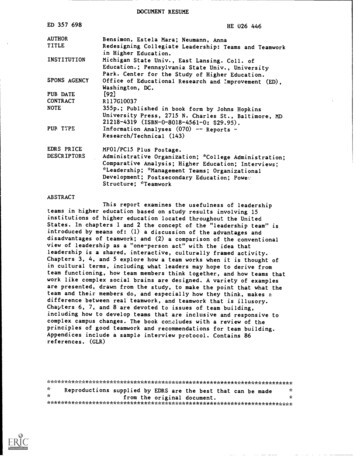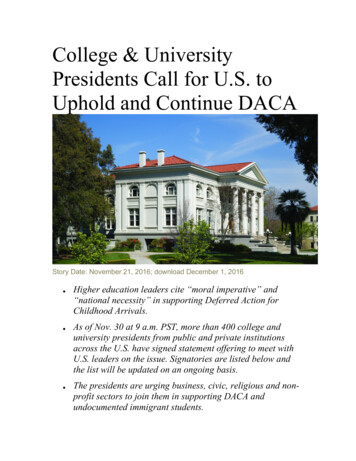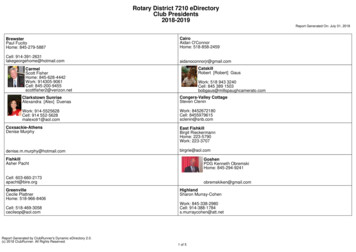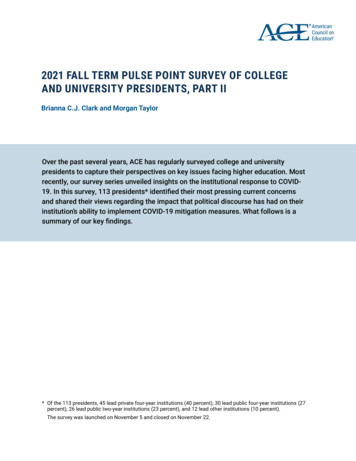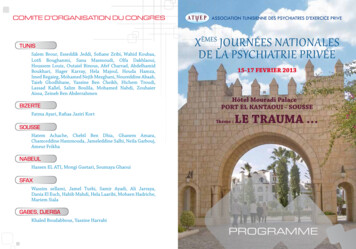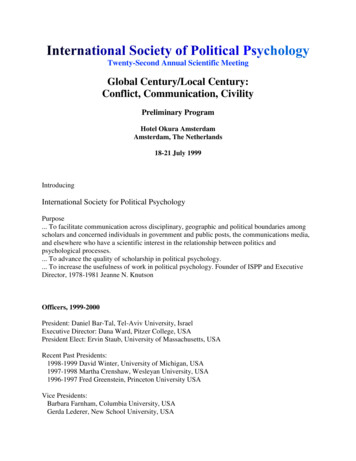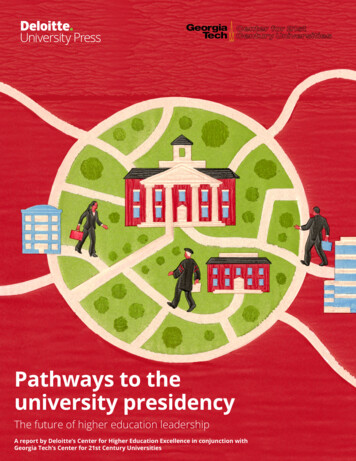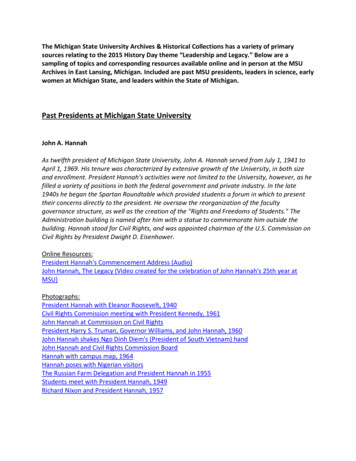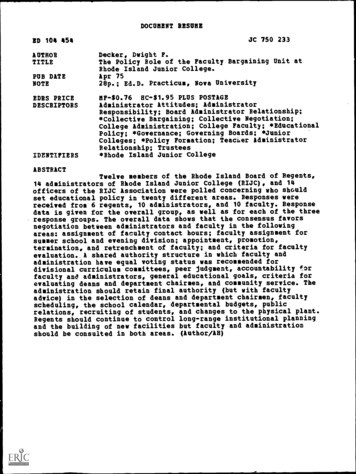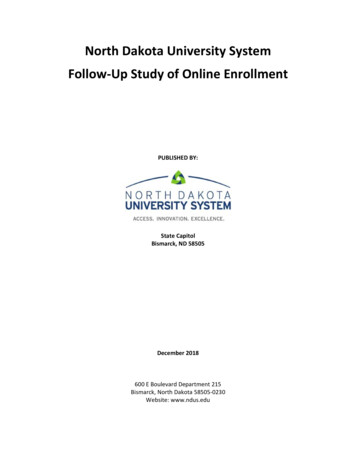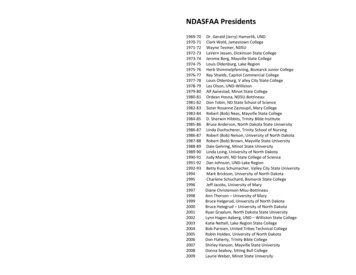
Transcription
NDASFAA r. Gerald (Jerry) Hamerlik, UNDClark Wold, Jamestown CollegeWayne Tesmer, NDSULaVern Jessen, Dickinson State CollegeJerome Berg, Mayville State CollegeLouis Oldenburg, Lake RegionHerb Shimmelpfenning, Bismarck Junior CollegeRay Shields, Capitol Commercial CollegeLouis Oldenburg, V alley City State CollegeLes Olson, UND-WillistonAlf Aanestad, Minot State CollegeOrdean Hosna, NDSU-BottineauDon Tobin, ND State School of ScienceSister Rosanne Zastoupil, Mary CollegeRobert (Bob) Neas, Mayville State CollegeD. Sherwin Hibbits, Trinity Bible InstituteBruce Anderson, North Dakota State UniversityLinda Duchscherer, Trinity School of NursingRobert (Bob) Nelson, University of North DakotaRobert (Bob) Brown, Mayville State UniversityDale Gehring, Minot State UniversityLinda Loing, University of North DakotaJudy Marohl, ND State College of ScienceDan Johnson, UND-Lake RegionBetty Kuss Schumacher, Valley City State UniversityMark Brickson, University of North DakotaCharlene Schuchard, Bismarck State CollegeJeff Jacobs, University of MaryDiane Christenson Misu-BottineauAnn Thorson – University of MaryBruce Helgerud, University of North DakotaBruce Helegrud – University of North DakotaRyan Graalum, North Dakota State UniversityLynn Hagen Aaberg, UND – Williston State CollegeKatie Nettell, Lake Region State CollegeBob Parisien, United Tribes Technical CollegeRobin Holden, University of North DakotaDon Flaherty, Trinity Bible CollegeShirley Hanson, Mayville State UniversityDonna Seaboy, Sitting Bull CollegeLaurie Weber, Minot State University
Thanks for the Memories .With the passage of the National Defense Education Act of 1958, theUnited States entered a new era in its long standing support forhigher education. While student aid, based on need for funding, hadexisted since 1643 (when Lady Anne Mowlson made a gift of onehundred pounds to Harvard University for the benefit of a “poorscholar”), governmental support had not customarily been centeredon universities but to admitting new states in the early nineteenthcentury. The creation of the land grant colleges in 1862 characterizedthe limited role of the federal government in higher education priorto the twentieth century. With the depression of the 1930’s came avariety of government programs designed to assist individuals.Among these the National Youth Administration included funds forthe employment of college students. This program, however, wasdesigned with the same basic idea as other New Deal efforts: to“provide young people with something to do,” as opposed toproviding assistance to promote access to higher education. In 1944the G. I. Bill: enabled thousands of veterans of the armed forces topay the costs of postsecondary education.This Act, whichrepresented the desire of the nation to reward its veterans for theirmilitary service, had the secondary impact of popularizing the ideathat large numbers of people could benefit from a college education.Still, in the decade after World War II there was no popular demandfor federal involvement in student assistance. In 1957, however, anexternal event galvanized public opinion. The Soviet launching ofSputnik in the fall of that year evoked an outcry from the Americanpeople, who were culturally unprepared to be second-best inanything, especially second to the Russians in outer space. Would theSoviets press their new scientific superiority in to advancedweaponry? How had America allowed such a dangerous event totake place? Who was to blame for the apparent American inferiority?Certainly not the Congress, that body promptly asserted. The realproblem, the Congress said, lay in “the ‘weakness’ of the Americaneducational system” and required a “new, dynamic, and totalcommitment to the problems facing higher education” (obtained fromNASFAA the First Twenty Years).As a part of planning for defending this great nation, the NationalDefense Education Act of 1958 created the National Defense StudentLoan Program. Concern for defending this country was of firstpriority. The first interest rate was 3%, but before a student couldreceive funds under this program, the student was required to sign anoath in the following form: “I do solemnly swear (or affirm) that Ibear true faith and allegiance to the United States of America and willsupport and defend the Constitution and laws of the United Statesagainst all its enemies, foreign and domestic.With the signing of the Economic Opportunity Act on August 20, 1964by President Lyndon B. Johnson, federal assistance for students toattend college took a giant step forward by creating the CollegeWork-Study Program. This program was another step toward thegoal of making higher education available to all who might benefitfrom it. The success of this program would depend not only on itsbeing administered in conjunction with the National Defense StudentLoan Program, but also on close cooperation between institutionsand officials in communities dealing with the problems of poverty.The Educational Opportunity Grant Program was authorized by TitleIV, Part A of the Higher Education Act of 1965. The purpose of thisprogram was to provide Educational Opportunity Grants to studentsof exceptional financial need who, for the lack of financial means oftheir own or of their family, would be unable to enter or remain in aninstitution of higher education without such assistance.In the beginning this grant started with an “Initial” grant for first timerecipients and a “Renewal” grant for returning previous recipients.This meant record keeping for each funding level. The first grantsprovided a minimum level of 200 and a maximum of 1,000 peryear.
Schools were notified by telegram as to funding levels by theircongressman.NDSCS - Don Tobin, Jamestown College - Clark Wold, Mary College Harold Miller(?).During the early years, the two forms of determining need analysiswere the College Scholarship Service Parent’s Confidential Statementand the American College Testing Family Financial Statement.In the summer of 1969, a Financial Aid Workshop was held on thecampus of the University of North Dakota. Dr. Hamerlik set thisworkshop up as a graduate credit course and brought in suchnotables as Leo Gilchrist of College Scholarship Service (CSS) and JimMoore,National Director of Student Financial Aid from the Dept ofHealth, Education and Welfare. It was at that time a need to organizethe financial aid directors in North Dakota was felt.The beginning of the Guaranteed Student Loan Program came aboutby the provision of “seed money”. Many schools chose to deposittheir “seed money” with United Student Aid Funds. This agency USAFwould then guarantee the loans to the students and would alsoadminister the program.Parts of this great country may consider North Dakota as behind thetimes, but we had some great visionaries back then. Martin “Buck”Stenehjem, Vice President of the Bank of North Dakota, approved thevery first Federally Insured Student Loan in the nation, on August 10,1967. The loan was made to Grady Porter who was enrolled atBismarck Junior College.Financial aid was new, and for many schools it was difficult to decideexactly how or who should handle the programs. It was notuncommon to see this duty added to a current position. At ValleyCity State University for example, Ellen Kienitz started working withfinancial aid while secretary to the college president.But change had started and slowly financial aid organization startedto form across the country.The first organized state meeting of financial aid personnel was heldin the fall of 1968 at Bismarck Junior College with 14 attendees.Attending were: LRSC - Merrill Berg, Minot - Oscar Peterson, Mayville- Everett Scholten, UND - Jerry Hamerik, Bottineau – (?), Dickinson Palmer Aasmunstad, VCSU - Ellen Kienitz, BSC - HerbSchimmelpfenning, UND-W - Garvin Stevens, NDSU - Wayne Tesmer,Following the workshop, the first meeting as an unofficialorganization was then held at UND on June 2, 1969. Fifteen peopleattended this organizational meeting: Dr. Gerald Hamerik – UND,Herb Schimmelpfenning – BJC, Raymond H. Dwelle – Mary College,Lowell D. White – Mary College, Robert J. Poss – WSSS, Mrs. AvelonUlmer – UNDEB, Clark J. Wold – Jamestown College, Bryan S,. Lonski –NDSU, Ken Anderson – NDSU, Wayne Tesmer – NDSU, Susan Gutches– NDSU, Garvins Stevens – UND-WC, LaVern Jessen – DSC, Alf A.Aanestad – MSC, Ellen Kienitz – VCSC. The first order of business wasto formally organize and to elect the first slate of officers. Dr. GeraldHamerlik of the University of North Dakota was elected as President.President-Elect was Clark Wold of Jamestown College. SecretaryTreasurer was Bryan Lonski of North Dakota State University.Fifteen people were in attendance and annual dues were set at 1.00.Programs discussed were National Defense Student Loan, EducationalOpportunity Grant, the College Work-Study Program and theFederally Insured Student Loan Program.Realizing the importance of training and understanding, theassociation developed its first Financial Aid Video for high schoolcounselors in the summer of 1969.At the beginning of NDASFAA, the association alined itself with theMidwest Association of Student Financial Aid Administrators, and
with the American Personnel and Guidance Association. This wasdone since Dr. Hamerlik was on the commission, and chaired theNational Organization for Student Financial Aid, which was derivedout of APGA.Since North Dakota had a chapter of NDPGA, NDASFAA tied itself tothis organization. Ultimately, this alliance was broken since NDASFAAfelt it did not have “a lot in common with NDPGA”.At that time, North Dakota was associated with the regional USDEoffices in Kansas City.In the late 60’s, individuals involved with financial aid met atJamestown College to decide whether to use the ACT form or theCollege Scholarship Form. At that time, Clark Wold of Jamestown andWayne Tesmer of NDSU, felt that the CSS process was the best andmost appropriate for North Dakota, since it favored farmers. The ACTprocess and how it analyzed information favored the wage earner.Early on, it appeared that this could create problems, but memberswere working together to resolve the issue.By December, 1969 twenty-six names were on the first paid NDASFAAmembership roster. The first official meeting as a state associationwas held in February, 1970 with Dr. Whelan, Program Officer, USDept of HEW, Kansas City, announcing that North Dakota would soonbe shifted from Region VII (Kansas City) to Region VIII (Denver). Thisaction proceeded to take place during the summer of 1970.The Holiday Inn in Bismarck was the setting of the business meetingon February 12, 1970. Income from dues was 27.00 with noexpenses recorded.August, 1970 saw a need for the association to consider raising theyearly dues to 2.00.Harry Collins from the University of Northern Colorado, and the thenPresident of RMASFAA, extended an invitation to NDASFAA to affiliatewith that association in January, 1971.On February 19, 1971, at the Holiday Inn in Bismarck, Treasurer DonTobin reported a cash balance of 62.44 (after the meeting,additional dues were collected and the balance was increased to 66.44). The association declared intent to align with RMASFAA, andinstitutional dues were increased to 10 per year.In June, 1971 the NDASFAA Executive Committee proposed anamendment to the by-laws to change affiliation from the MidwestAssociation to the Rocky Mountain Association.In July, 1971, the first Medora meeting was held (with a barbecue)and the association formally approved alignment with RMASFAA. Thebusiness meeting took place at the Museum Library.November, 1971 Grady Porter (a transfer from Bismarck JuniorCollege) went on to graduate from Valley City State College in aspecial graduation ceremony held at the VCSC Student CenterPresident’s Room. Recognition was given to Grady for being the firstFederally Insured Student Loan borrower in the nation. North DakotaGovernor William Guy was present along with other dignitaries fromthe capitol.Martin Stenehjem of the Bank of North Dakota reported on February28, 1972, “that students can apply for a FISL loan of 1,500 in thefall.” However, only 1,000 would be disbursed in the first half of theyear and the additional 500 would be disbursed upon writtenrequest from the student. Pink cards would be sent to the schoolwith the first check and the student would be required to later signand return the card to the bank for the second dispersal.At the meeting held at Lake Metigoshe, near Bottineau, Treasurer RayDwelle reported that, “.all bills were paid we have 134.21 in the
bank. In all, we had a very good year.” It is unknown if thisstatement was made before or after Ray Dwelle and Clark Wolddecided to take a swim after breaking through the ice on the lakewhile hunting ducks. Was this how polar bear clubs got started?On June 23, 1972, the Education Amendments of 1972 became law.The amendments authorized the following name changes: 1. TheNational Defense Student Loan Program became the National DirectStudent Loan Program. 2. Educational Opportunity Grant wasdropped and replaced with the Supplemental EducationalOpportunity Grant. The SEOG was to be considered a grant“supplemental” to the newly authorized “Basic” Opportunity Grant.The law governing the National Defense Student Loan Program nolonger required the signing of a Loyalty Oath for loans received afterJune 30, 1972. The law did require the submission of an Affidavit ofEducational Purpose for loans and grants received after August 23,1972.Created by the 1972 amendments, the Basic Opportunity GrantProgram (BOG) was first available in 1973-74. Basic Grants weremade only to eligible students who had not been enrolled in postsecondary education prior to April 1, 1973. Aid administrators wereassured that this program would involve very little to no work andwould be very easy to administer. First grants were calculated byusing a “wheel”. Maximum grant level for the first Basic Grant was 1,400. In addition, the sum of the family contribution plus the BasicGrant could exceed the actual cost of attendance.During this time and for the next six years, Dr. Hamerlik of UNDserved as Dept. of HEW trainer for North Dakota for the BasicOpportunity Grant Program.On June 23, 1972 limits on the Federally Insured Student Loan wereraised from 1,500 to 2,500 annually.Prior to this time, the Board of Higher Education Office gave stateinstitutions the right to award scholarship waivers based on apercentage of individual enrollment.The 1973 ND Legislature then passed a law to implement the StateGrant Program, at which time the Board of Higher Education lost theirauthority to award scholarship waivers at public institutions.For the 1972-73 academic year, 3,000 had been allocated. For thefirst year, the program was handled by Dr. Hamerlik’s office at UND.The fall state meeting was held on September 24, 1972 at the HolidayInn in Bismarck.The 1972 RMASFAA Conference was at the Roadway Inn in Boise,Idaho on October 11, 1972.The summer of 1973 saw the creation of the ND State Grant ProgramOffice with Clark Wold leaving Jamestown College to be the Directorout of the Board of Higher Education Office in Bismarck. Firstselections were based on the parent’s contribution. Later thecalculation was on actual need.Those involved in aid administration during the summer of 1973 wereextremely upset by the turmoil created when ACT and CSS began totreat farm assets differently for family contribution calculationpurposes. This caused administrators to create and utilize the “Lonskimethod” (developed by Bryan Lonski) as a means of reconciling thetwo systems, and to provide a better method of calculating the familycontribution.By the fall of 1973, the maximum level for the SupplementalEducational Opportunity Grant had been increased to 1,500.Early in 1973 after much confusion and irritation generated byinconsistencies between the treatment of farm families and business
assets, the association voted to identify ACT as the preferred needanalysis service in October, 1973. Also discussed at this meeting wascontinuation of a special application for minority students (FamilyIncome Statement). The American College Testing/Family FinancialStatement was used as the preferred analysis form in North Dakotafor the fall of 1974.Wayne Tesmer of NDSU served as President of RMASFAA for 1973-74.Because of its geographical location, Bismarck was a popular site asthe next meeting was again at the Holiday Inn on February 14, 1974.The first meeting held at the Chieftain Motel in Carrington was onMay 10, 1974.The first RMASFAA conference in the state of ND was held at theFargo Holiday Inn in October, 1974.Back to the Holiday Inn in Bismarck February 14, 1975. Did theassociation have something going with this hotel?Funds were slowly picking up as Treasurer Dave Soliah reported onJuly 1, 1975 that the treasury had a cash balance of 746.61.The fall conference was held in the ND State School of ScienceStudent Center at Wahpeton on September 15, 1975.When the next meeting was held in January, 1976, PresidentShimmelpfenning announced that a 3.00 registration fee would becharged to cover the cost of coffee and incidentals. A portion of thefee was also used to pay travel expenses for some of the programparticipants.September 16, 1976 saw the state meeting at the Seven Seas inMandan.In January, 1977, Wayne Tesmer of NDSU and Ken Wallace ofJamestown College submitted a Special Report to the membershipregarding “ACT Needs Analysis and the Farm Family Problems andSolutions”.Site: Bismarck Holiday Inn on February 11, 1977. At this time it wasdecided to discontinue BEOG workshops for high school counselors.Basic grant officials suggested using fall training dates within our stateand Tom Monahan suggested using ND personnel for a two dayworkshop in two sites for the purpose of raising money for theassociation and training high school counselors.February 21, 1977 President Ray Shields appointed a committee todraft a Need Analysis Service Supplement Form to be included withthe ACT application.The US Dept of Health, Education and Welfare issued a news releaseon April 8, 1977 informing the public that starting with the 1977-78academic year, “Students receiving financial aid must be in GoodStanding and making Satisfactory Progress in the course of study theyare pursuing.”May 3, 1977 institutions were notified that for the 1976-77 academicyear institutions would be allowed to draw down a 4% administrativeexpense for the Supplemental Educational Opportunity Grant andCollege Work-Study. However, the administrative allowance for theNDSL Program would remain at 3%.Everyone traveled back to Bismarck on May 14, 1977 to the RamadaInn for update training.Memo dated September 9, 1977: Effective August 29, 1977, theadministration of the Guaranteed Student Loan Program, the threecampus-based student financial aid programs, and the BasicEducational Opportunity Grants program were consolidated to form aDivision of Student Financial Assistance. These programs would now
operate under a Regional Administrator reporting to the DeputyCommissioner for Student Financial Assistance and were thereforebeing separated from the Division of Higher and ContinuingEducation.The Education Amendments of 1980 changed the name of the Basic GrantProgram to the Pell Grant Program, in honor of Senator Claiborne Pell.Bismarck Junior College was selected for the next meeting on September 16,1980.On September 21, 1977 the meeting was held at the State HighwayDept. in Bismarck. Uniform methodology for 1978-79 would beperformed by CSS and ACT and this would be used to determineBEOG eligibility. Schools were advised not to hand out newapplications until after January 1, 1978.Regulations published on September 28, 1979, and amended on June 24,1980, now required institutions to establish policies regarding refunds andrepayments. For purposes of the regulations, refunds are those dollars tobe returned to the institution for tuition, fees, room, board, and/or othercharges as a result of a student’s withdrawing from the institution.Effective January 1, 1978 schools were asked to pay 2.65 per hour on thecollege work study program in keeping with the new minimum wage rates.The Ramada Inn in Grand Forks was the site of the meeting held onFebruary 12, 1981.In February, 1978 Clark Wold reported on the importance of a common aidapplication for state schools because of the upcoming state computersystem. As the computer system was in the early planning stages, Clark wasquick to point out that the accounting system would be #1 and should be upand running by July 1, 1979. Stated Clark: “Traditionally, aid hasn’t enjoyedmuch ‘status’ on our campuses and without that ‘status’ and the belief bytop administrators that what we do is critical to the school, it will be toughto get them to put aid at the top.”The Seven Seas Motel in Mandan was the site of the September 12, 1981meeting. Following this meeting, Don Tobin sent a memo remindingmembers of the Secretarial Workshop being held jointly with AdmissionsCounselors in Mandan, September 24-25.In January, 1979, Dr. Hamerlik prepared a revised proposal for certificationof state financial aid administrators.NDASFAA sponsored a seminar on financial aid for college presidents inFebruary, 1979 at the Seven Seas Motel in Mandan. The seminar wasattended by Dr. Dallas Martin of the National Association of StudentFinancial Aid Administrators and Tom Monahan of the Denver Office ofHEW.The first plans for a Secretarial Workshop were discussed at the meetingheld on February 15, 1980 at the Holiday Inn in Bismarck. Plans indicatedthe workshop would be held in July in Bismarck.Ethel Hensrud reported a treasury balance of 1,021.24 at the June, 1980meeting.On December 11, 1981 the first discussion for a consolidated point ofmailing of the FFS packet was brought up. LaVern Jessen moved thatNDASFAA take on this responsibility and the motion was seconded byWayne Tesmer.The Minot Holiday Inn was the site of the February 11, 1982 BusinessMeeting.The NDASFAA Newsletter announced in April, 1982 that a new gavel andblock had been purchased. Also, congratulations were extended to MartinStenehjem for being chosen Director of the new ND State Student LoanGuarantee Agency, and to Jeannine Christy who will be the new Director,Student Loan Division of the Bank of North Dakota.The NDASFAA Constitution was revised and adopted in June, 1982 to takeeffect July 1, 1982 (per NDASFAA newsletter June, 1982). The requirementthat we meet with the North Dakota Personnel and Guidance Associationwas eliminated.
The Mary College Butler Center in Bismarck was the site of the businessmeeting on September 23, 1982.At the December 11, 1982 state meeting held at the Jamestown Holiday Inn,Clark Wold reported on the Secretarial Workshop held in September.Discussion again centered on the central mailing of the FFS.At the May 5, 1983 meeting held at the Jamestown Holiday Inn, Clark Woldreported on the Secretarial Workshop held in September. Yet again,discussion centered on the central mailing of the FFS.Effective July 1, 1983 the federal government required that a student mustregister for the draft prior to receiving Title IV aid.Hot and dusty in the western part of the state, the state meeting was heldin Medora at the Community Center on August 12, 1983. “Rattlesnake Joe”(a.k.a. LaVern Jessen) came gunning for a “Fed” (a.k.a. Paul Tone).On December 12, 1983 the Comfort Inn in Bismarck was selected for thebusiness meeting.The matter of the FFS consolidated mailing again came up on August 10,1984 at the Sheraton Inn in Bismarck. It was decided that the mailing of theFFS was to remain as “unfinished business.”The annual conference was held at the Bismarck Holiday Inn December 1214, 1984. Clark Wold reported on the training conducted at high schoolcounselor workshops and concern regarding the cost of materials for theworkshops when no registration fee is charged to participants.The Training Committee met on September 25, 1985 at NDSU to discuss andplan the fall High School Counselor Workshops. It was agreed at this time tocharge 5 to participants for material at the site.At the October, 1985 RMASFAA conference held in Rapid City, SD, BruceAnderson of NDSU took office as RMASFAA President. This conference set arecord regarding meal planning since every meal consisted of chicken.The annual conference was held at the Radisson Inn in Fargo, November 2022, 1985. Outgoing President Sherwin Hibbits suggested a need for a logo.The NDASFAA Logo which appeared on a newsletter from President BruceAnderson in December, 1985 consisted of “NDASFAA” in the upper lefthand corner above a three inch picture frame corner.In December, 1985, Buck Stenehjem retired from Student Loans of NorthDakota. Many association members attended a retirement dinner given inhis honor by the Bank.1986 – Robert Nelson of UND received the RMASFAA Distinguished ServiceAward.Effective October 17, 1986, it was time for another program name change.The National Direct Student Loan Program changed its name to the PerkinsLoan Program in honor of Kentucky Congressman Carl D. Perkins.On August 7, 1986 the association returned to Medora for the summermeeting.October 17, 1986 the Higher Education Amendments of 1986 required aneeds test through an approved campus-based methodology for allborrowers applying for a Guaranteed Student Loan (GSL) or a SupplementalLoan for Students (SLS).The second RMASFAA Conference held in North Dakota was held at theSheraton Hotel in Bismarck. During this meeting, the state businessmeeting was held on October 19, 1986. The state meeting again consistedof a discussion regarding the mailing of the FFS. President Bob Nelson askedthe association for a decision regarding this matter. At this time, theassociation finally decided to have FFS packets mailed from a central point(the State Grant Office, under the direction of Clark Wold in Bismarcksupervising the arrangements). The association voted to allocate 1,000 tothe project with the balance of the cost billed to each institution based onenrollment. After a busy day of information overload, conference attendeeshad the opportunity to unwind at a barbecue and barn dance outside ofBismarck.The spring meeting was held at the Holiday Inn in Bismarck on May 1, 1987.The fall meeting was held at the Ramada Inn in Grand Forks in November,1987.
The Fargo Kelly Inn was the site for the spring meeting with the businessmeeting taking place on April 13, 1988. The association had been contactedby NDPGA requesting that we become affiliated with them. A motion wasmade by Dale Gehring and seconded by Bob Neas that the President ofNDASFAA be a liason between the two organizations.The RMASFAA Conference was held in Lincoln, Nebraska in October, 1988 atthe Cornhusker Hotel. Charlene Schuchard looked great in a grass skirt asshe embraced the Hawaiian Theme.The International Inn in Minot was the site of the state meeting anddecentralized training. The business meeting was held on November 15,1988.Effective July 1, 1988, the name of the Guaranteed Student Loan Programwas changed to the Robert T. Stafford Student Loan Program.On May 3, 1989 the spring meeting was held at the Dakota Inn inJamestown.At this time, a tele-conference was conducted withWashington, DC. New rules and problems to manage left members eagerfor a chance to unwind that evening with a mock Casino Night. Moneydepicting members of the association was used as currency and “pull-tabs”were the hit of the evening.In the fall of 1989, NDASFAA was asked to respond to the State Board ofHigh Education’s Task Force on Native American’s in Higher Educationcommittee regarding the financial aid issues addressed to the committee bythe Native American Higher Education specialists.A committee of representation from UND, NDSU, MSU and SBHE, met inCarrington on October 9th to discuss these issues and make somerecommendations to NDASFAA.1989 - Bruce Anderson of NDSU received the ‘first’ NASFAA LeadershipAward.1989 – Wayne Tesmer of NDSU was inducted into the RMASFAA Hall ofFame.The first joint meeting of ND/SD was held in Aberdeen, SD in November,1989 at the Ramada Inn. This joint venture was planned as a way of cuttingcosts and making it possible to draw better speakers/presenters.December 4, 1989 a business meeting was held in Bismarck at the KirkwoodInn. Bruce Anderson pointed out to members that unprofessional groupswere seeking membership in NDASFAA. Since currently the association bylaws only allow practicing Financial Aid Administrators who are payingmembers to be voting members, he advised the association to look toregional and national by-laws for guidance in this matter. Also at this time,the association took the time to honor Bruce who was leaving NDSU to joinACT in Denver.The next state conference took place at the Kelly Inn in Bismarck. Thebusiness meeting was held on April 2, 1990. At that time, Judy Marohl tookoffice as President after reading a letter of resignation from Linda Loing.Also at this meeting, Clark Wold informed schools that each would receive abill for their share of the FFS mailing.On April 3, 1990 the business meeting was reconvened at which time DanJohnson submitted the name of Dave Martin of Trinity Bible College as thenew President-Elect. The nomination was accepted by unanimous vote.At the August 9, 1990 business meeting held in Bismarck, the associationvoted to accept Student Loans of North Dakota’s offer to cover the costs ofmailing FFS packets to all high school seniors. The Publicity Committeedecided to take on the responsibility of
1984-85 D. Sherwin Hibbits, Trinity Bible Institute 1985-86 Bruce Anderson, North Dakota State University 1986-87 Linda Duchscherer, Trinity School of Nursing 1986-87 Robert (Bob) Nelson, University of North Dakota 1987-88 Robert (Bob) Brown, Mayville State University 1988-89 Dale Gehring, Minot State University
